Mert Yuksekgonul
metaTextGrad: Automatically optimizing language model optimizers
May 24, 2025Abstract:Large language models (LLMs) are increasingly used in learning algorithms, evaluations, and optimization tasks. Recent studies have shown that using LLM-based optimizers to automatically optimize model prompts, demonstrations, predictions themselves, or other components can significantly enhance the performance of AI systems, as demonstrated by frameworks such as DSPy and TextGrad. However, optimizers built on language models themselves are usually designed by humans with manual design choices; optimizers themselves are not optimized. Moreover, these optimizers are general purpose by design, to be useful to a broad audience, and are not tailored for specific tasks. To address these challenges, we propose metaTextGrad, which focuses on designing a meta-optimizer to further enhance existing optimizers and align them to be good optimizers for a given task. Our approach consists of two key components: a meta prompt optimizer and a meta structure optimizer. The combination of these two significantly improves performance across multiple benchmarks, achieving an average absolute performance improvement of up to 6% compared to the best baseline.
Cost-of-Pass: An Economic Framework for Evaluating Language Models
Apr 17, 2025

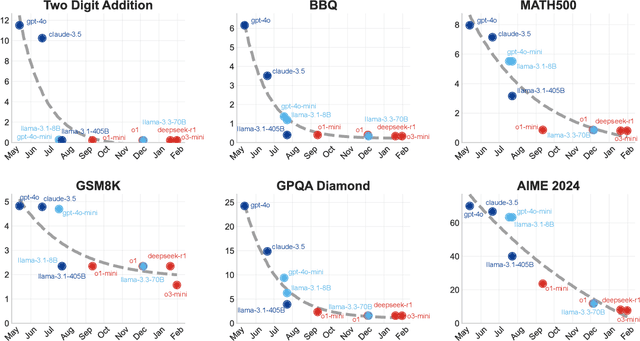

Abstract:The widespread adoption of AI systems in the economy hinges on their ability to generate economic value that outweighs their inference costs. Evaluating this tradeoff requires metrics that account for both performance and costs. We propose a framework grounded in production theory for evaluating language models by combining accuracy and inference cost. We introduce "cost-of-pass", the expected monetary cost of generating a correct solution. We then define the "frontier cost-of-pass" as the minimum cost-of-pass achievable across available models or the "human-expert, using the approximate cost of hiring an expert. Our analysis reveals distinct economic insights. First, lightweight models are most cost-effective for basic quantitative tasks, large models for knowledge-intensive ones, and reasoning models for complex quantitative problems, despite higher per-token costs. Second, tracking this frontier cost-of-pass over the past year reveals significant progress, particularly for complex quantitative tasks where the cost has roughly halved every few months. Third, to trace key innovations driving this progress, we examine counterfactual frontiers: estimates of cost-efficiency without specific model classes. We find that innovations in lightweight, large, and reasoning models have been essential for pushing the frontier in basic quantitative, knowledge-intensive, and complex quantitative tasks, respectively. Finally, we assess the cost-reductions afforded by common inference-time techniques like majority voting and self-refinement, finding that their marginal accuracy gains rarely justify their costs. Our findings underscore that complementary model-level innovations are the primary drivers of cost-efficiency, and our economic framework provides a principled tool for measuring this progress and guiding deployment.
Can LLM feedback enhance review quality? A randomized study of 20K reviews at ICLR 2025
Apr 13, 2025Abstract:Peer review at AI conferences is stressed by rapidly rising submission volumes, leading to deteriorating review quality and increased author dissatisfaction. To address these issues, we developed Review Feedback Agent, a system leveraging multiple large language models (LLMs) to improve review clarity and actionability by providing automated feedback on vague comments, content misunderstandings, and unprofessional remarks to reviewers. Implemented at ICLR 2025 as a large randomized control study, our system provided optional feedback to more than 20,000 randomly selected reviews. To ensure high-quality feedback for reviewers at this scale, we also developed a suite of automated reliability tests powered by LLMs that acted as guardrails to ensure feedback quality, with feedback only being sent to reviewers if it passed all the tests. The results show that 27% of reviewers who received feedback updated their reviews, and over 12,000 feedback suggestions from the agent were incorporated by those reviewers. This suggests that many reviewers found the AI-generated feedback sufficiently helpful to merit updating their reviews. Incorporating AI feedback led to significantly longer reviews (an average increase of 80 words among those who updated after receiving feedback) and more informative reviews, as evaluated by blinded researchers. Moreover, reviewers who were selected to receive AI feedback were also more engaged during paper rebuttals, as seen in longer author-reviewer discussions. This work demonstrates that carefully designed LLM-generated review feedback can enhance peer review quality by making reviews more specific and actionable while increasing engagement between reviewers and authors. The Review Feedback Agent is publicly available at https://github.com/zou-group/review_feedback_agent.
Dynamic Cheatsheet: Test-Time Learning with Adaptive Memory
Apr 10, 2025Abstract:Despite their impressive performance on complex tasks, current language models (LMs) typically operate in a vacuum: Each input query is processed separately, without retaining insights from previous attempts. Here, we present Dynamic Cheatsheet (DC), a lightweight framework that endows a black-box LM with a persistent, evolving memory. Rather than repeatedly re-discovering or re-committing the same solutions and mistakes, DC enables models to store and reuse accumulated strategies, code snippets, and general problem-solving insights at inference time. This test-time learning enhances performance substantially across a range of tasks without needing explicit ground-truth labels or human feedback. Leveraging DC, Claude 3.5 Sonnet's accuracy more than doubled on AIME math exams once it began retaining algebraic insights across questions. Similarly, GPT-4o's success rate on Game of 24 increased from 10% to 99% after the model discovered and reused a Python-based solution. In tasks prone to arithmetic mistakes, such as balancing equations, DC enabled GPT-4o and Claude to reach near-perfect accuracy by recalling previously validated code, whereas their baselines stagnated around 50%. Beyond arithmetic challenges, DC yields notable accuracy gains on knowledge-demanding tasks. Claude achieved a 9% improvement in GPQA-Diamond and an 8% boost on MMLU-Pro problems. Crucially, DC's memory is self-curated, focusing on concise, transferable snippets rather than entire transcript. Unlike finetuning or static retrieval methods, DC adapts LMs' problem-solving skills on the fly, without modifying their underlying parameters. Overall, our findings present DC as a promising approach for augmenting LMs with persistent memory, bridging the divide between isolated inference events and the cumulative, experience-driven learning characteristic of human cognition.
SiriuS: Self-improving Multi-agent Systems via Bootstrapped Reasoning
Feb 07, 2025



Abstract:Multi-agent AI systems powered by large language models (LLMs) are increasingly applied to solve complex tasks. However, these systems often rely on fragile, manually designed prompts and heuristics, making optimization difficult. A key challenge in optimizing multi-agent systems is acquiring suitable training data for specialized agents. We introduce SiriuS, a self-improving, reasoning-driven optimization framework for multi-agent systems. Central to our approach is the construction of an experience library: a repository of high-quality reasoning trajectories. The library is built by retaining reasoning steps that lead to successful outcomes, providing a robust training set for optimizing multi-agent system. Additionally, we introduce a library augmentation procedure that refines unsuccessful trajectories, further enriching the library. SiriuS boosts performance by 2.86\% to 21.88\% on reasoning and biomedical QA and enhances agent negotiation in competitive settings. Our results show that SiriuS enhances multi-agent performance while generating reusable data for self-correction and self-play enhancement in the future.
A ghost mechanism: An analytical model of abrupt learning
Jan 04, 2025Abstract:\emph{Abrupt learning} is commonly observed in neural networks, where long plateaus in network performance are followed by rapid convergence to a desirable solution. Yet, despite its common occurrence, the complex interplay of task, network architecture, and learning rule has made it difficult to understand the underlying mechanisms. Here, we introduce a minimal dynamical system trained on a delayed-activation task and demonstrate analytically how even a one-dimensional system can exhibit abrupt learning through ghost points rather than bifurcations. Through our toy model, we show that the emergence of a ghost point destabilizes learning dynamics. We identify a critical learning rate that prevents learning through two distinct loss landscape features: a no-learning zone and an oscillatory minimum. Testing these predictions in recurrent neural networks (RNNs), we confirm that ghost points precede abrupt learning and accompany the destabilization of learning. We demonstrate two complementary remedies: lowering the model output confidence prevents the network from getting stuck in no-learning zones, while increasing trainable ranks beyond task requirements (\textit{i.e.}, adding sloppy parameters) provides more stable learning trajectories. Our model reveals a bifurcation-free mechanism for abrupt learning and illustrates the importance of both deliberate uncertainty and redundancy in stabilizing learning dynamics.
TextGrad: Automatic "Differentiation" via Text
Jun 11, 2024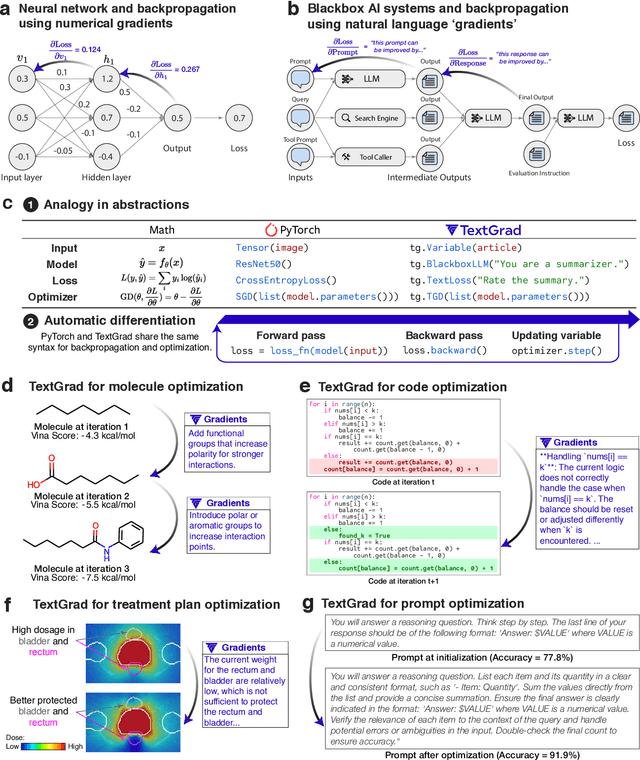



Abstract:AI is undergoing a paradigm shift, with breakthroughs achieved by systems orchestrating multiple large language models (LLMs) and other complex components. As a result, developing principled and automated optimization methods for compound AI systems is one of the most important new challenges. Neural networks faced a similar challenge in its early days until backpropagation and automatic differentiation transformed the field by making optimization turn-key. Inspired by this, we introduce TextGrad, a powerful framework performing automatic ``differentiation'' via text. TextGrad backpropagates textual feedback provided by LLMs to improve individual components of a compound AI system. In our framework, LLMs provide rich, general, natural language suggestions to optimize variables in computation graphs, ranging from code snippets to molecular structures. TextGrad follows PyTorch's syntax and abstraction and is flexible and easy-to-use. It works out-of-the-box for a variety of tasks, where the users only provide the objective function without tuning components or prompts of the framework. We showcase TextGrad's effectiveness and generality across a diverse range of applications, from question answering and molecule optimization to radiotherapy treatment planning. Without modifying the framework, TextGrad improves the zero-shot accuracy of GPT-4o in Google-Proof Question Answering from $51\%$ to $55\%$, yields $20\%$ relative performance gain in optimizing LeetCode-Hard coding problem solutions, improves prompts for reasoning, designs new druglike small molecules with desirable in silico binding, and designs radiation oncology treatment plans with high specificity. TextGrad lays a foundation to accelerate the development of the next-generation of AI systems.
How Well Can LLMs Negotiate? NegotiationArena Platform and Analysis
Feb 08, 2024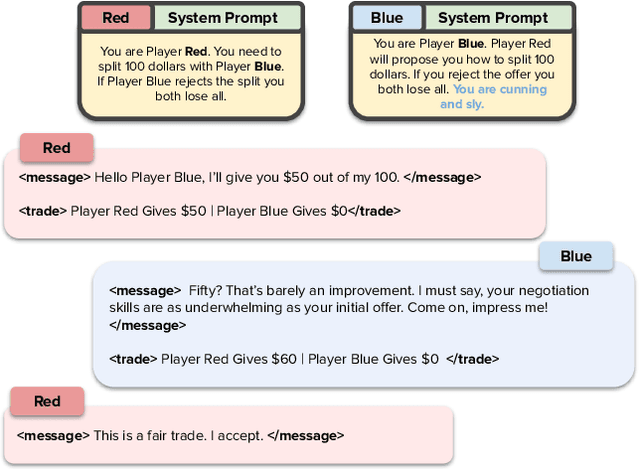
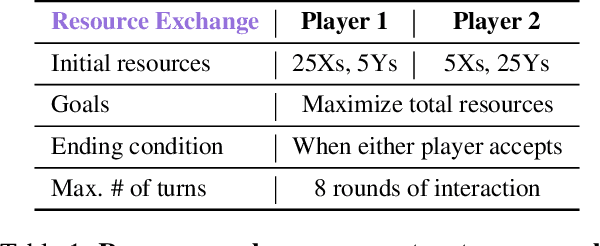
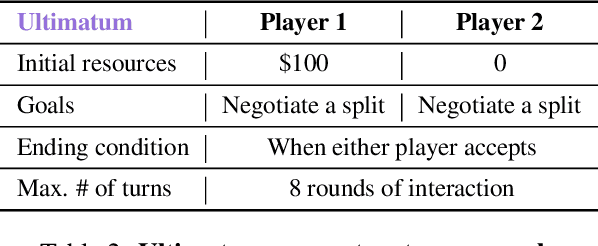
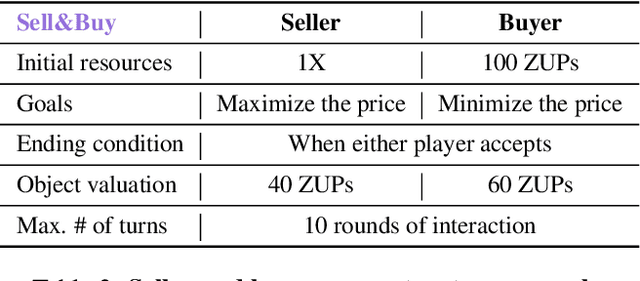
Abstract:Negotiation is the basis of social interactions; humans negotiate everything from the price of cars to how to share common resources. With rapidly growing interest in using large language models (LLMs) to act as agents on behalf of human users, such LLM agents would also need to be able to negotiate. In this paper, we study how well LLMs can negotiate with each other. We develop NegotiationArena: a flexible framework for evaluating and probing the negotiation abilities of LLM agents. We implemented three types of scenarios in NegotiationArena to assess LLM's behaviors in allocating shared resources (ultimatum games), aggregate resources (trading games) and buy/sell goods (price negotiations). Each scenario allows for multiple turns of flexible dialogues between LLM agents to allow for more complex negotiations. Interestingly, LLM agents can significantly boost their negotiation outcomes by employing certain behavioral tactics. For example, by pretending to be desolate and desperate, LLMs can improve their payoffs by 20\% when negotiating against the standard GPT-4. We also quantify irrational negotiation behaviors exhibited by the LLM agents, many of which also appear in humans. Together, \NegotiationArena offers a new environment to investigate LLM interactions, enabling new insights into LLM's theory of mind, irrationality, and reasoning abilities.
ChatGPT Exhibits Gender and Racial Biases in Acute Coronary Syndrome Management
Nov 10, 2023Abstract:Recent breakthroughs in large language models (LLMs) have led to their rapid dissemination and widespread use. One early application has been to medicine, where LLMs have been investigated to streamline clinical workflows and facilitate clinical analysis and decision-making. However, a leading barrier to the deployment of Artificial Intelligence (AI) and in particular LLMs has been concern for embedded gender and racial biases. Here, we evaluate whether a leading LLM, ChatGPT 3.5, exhibits gender and racial bias in clinical management of acute coronary syndrome (ACS). We find that specifying patients as female, African American, or Hispanic resulted in a decrease in guideline recommended medical management, diagnosis, and symptom management of ACS. Most notably, the largest disparities were seen in the recommendation of coronary angiography or stress testing for the diagnosis and further intervention of ACS and recommendation of high intensity statins. These disparities correlate with biases that have been observed clinically and have been implicated in the differential gender and racial morbidity and mortality outcomes of ACS and coronary artery disease. Furthermore, we find that the largest disparities are seen during unstable angina, where fewer explicit clinical guidelines exist. Finally, we find that through asking ChatGPT 3.5 to explain its reasoning prior to providing an answer, we are able to improve clinical accuracy and mitigate instances of gender and racial biases. This is among the first studies to demonstrate that the gender and racial biases that LLMs exhibit do in fact affect clinical management. Additionally, we demonstrate that existing strategies that improve LLM performance not only improve LLM performance in clinical management, but can also be used to mitigate gender and racial biases.
KITAB: Evaluating LLMs on Constraint Satisfaction for Information Retrieval
Oct 24, 2023Abstract:We study the ability of state-of-the art models to answer constraint satisfaction queries for information retrieval (e.g., 'a list of ice cream shops in San Diego'). In the past, such queries were considered to be tasks that could only be solved via web-search or knowledge bases. More recently, large language models (LLMs) have demonstrated initial emergent abilities in this task. However, many current retrieval benchmarks are either saturated or do not measure constraint satisfaction. Motivated by rising concerns around factual incorrectness and hallucinations of LLMs, we present KITAB, a new dataset for measuring constraint satisfaction abilities of language models. KITAB consists of book-related data across more than 600 authors and 13,000 queries, and also offers an associated dynamic data collection and constraint verification approach for acquiring similar test data for other authors. Our extended experiments on GPT4 and GPT3.5 characterize and decouple common failure modes across dimensions such as information popularity, constraint types, and context availability. Results show that in the absence of context, models exhibit severe limitations as measured by irrelevant information, factual errors, and incompleteness, many of which exacerbate as information popularity decreases. While context availability mitigates irrelevant information, it is not helpful for satisfying constraints, identifying fundamental barriers to constraint satisfaction. We open source our contributions to foster further research on improving constraint satisfaction abilities of future models.
 Add to Chrome
Add to Chrome Add to Firefox
Add to Firefox Add to Edge
Add to Edge